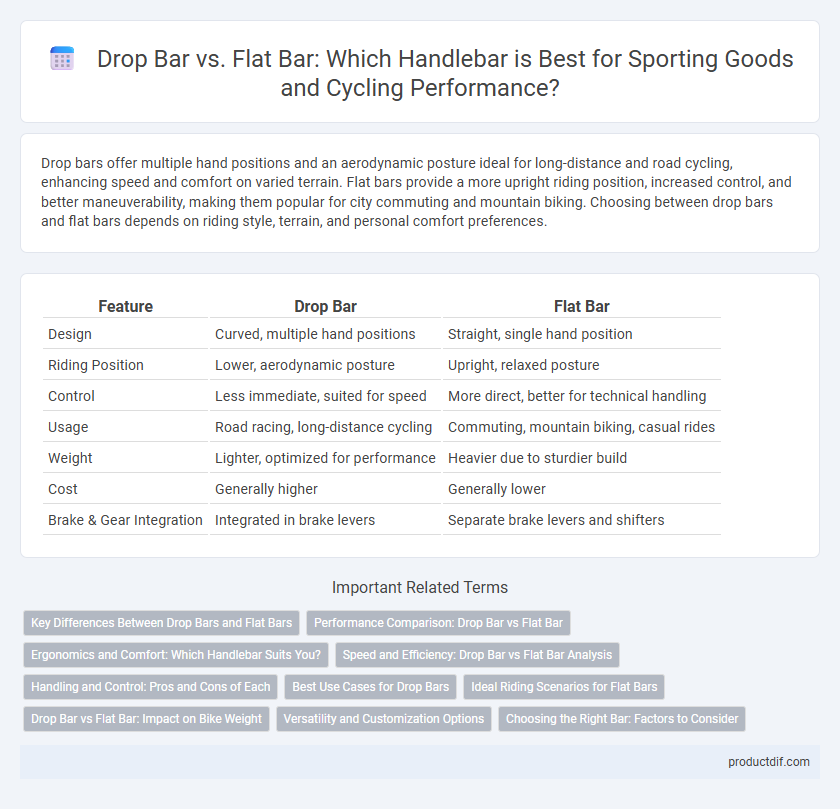Drop bars offer multiple hand positions and an aerodynamic posture ideal for long-distance and road cycling, enhancing speed and comfort on varied terrain. Flat bars provide a more upright riding position, increased control, and better maneuverability, making them popular for city commuting and mountain biking. Choosing between drop bars and flat bars depends on riding style, terrain, and personal comfort preferences.
Table of Comparison
| Feature | Drop Bar | Flat Bar |
|---|---|---|
| Design | Curved, multiple hand positions | Straight, single hand position |
| Riding Position | Lower, aerodynamic posture | Upright, relaxed posture |
| Control | Less immediate, suited for speed | More direct, better for technical handling |
| Usage | Road racing, long-distance cycling | Commuting, mountain biking, casual rides |
| Weight | Lighter, optimized for performance | Heavier due to sturdier build |
| Cost | Generally higher | Generally lower |
| Brake & Gear Integration | Integrated in brake levers | Separate brake levers and shifters |
Key Differences Between Drop Bars and Flat Bars
Drop bars offer multiple hand positions and aerodynamic advantages, making them ideal for road cycling and long-distance rides. Flat bars provide a more upright riding posture, enhancing control and comfort, which suits mountain biking and casual city riding. Weight and handling responsiveness also vary, with drop bars generally lighter and flat bars offering better maneuverability at lower speeds.
Performance Comparison: Drop Bar vs Flat Bar
Drop bars offer an aerodynamic riding position that enhances speed and efficiency, making them ideal for road cycling and long-distance performance. Flat bars provide superior control and maneuverability, favored in mountain biking and urban commuting for stability and quick handling. Riders seeking maximum speed and endurance benefit from drop bars, while those prioritizing comfort and precise steering perform better with flat bars.
Ergonomics and Comfort: Which Handlebar Suits You?
Drop bars offer multiple hand positions, promoting ergonomic benefits by reducing hand fatigue on long rides and enhancing comfort through varied grip angles. Flat bars provide a more natural wrist posture and wider control, which improves stability and comfort, especially for casual or urban cyclists. Choosing between drop bars and flat bars depends on your riding style and ergonomic needs, with drop bars favoring endurance and flat bars excelling in upright comfort.
Speed and Efficiency: Drop Bar vs Flat Bar Analysis
Drop bars enhance aerodynamics by enabling a lower riding position, which reduces wind resistance and increases speed, making them ideal for road cycling and racing. Flat bars offer a more upright posture that improves control and comfort but generally produce higher drag, resulting in slower speeds over long distances. The efficiency of drop bars in maintaining high velocity is supported by their ergonomic design that promotes power transfer and reduces muscle fatigue.
Handling and Control: Pros and Cons of Each
Drop bars offer enhanced aerodynamic positioning and multiple hand placements, improving control during high-speed cycling and long-distance rides, but can be challenging for beginners due to their curved design. Flat bars provide a more upright posture, promoting better visibility and easier maneuverability in urban environments, though they may sacrifice some aerodynamic efficiency and hand position variety. Choosing between drop and flat bars depends on the rider's preference for comfort, bike handling, and intended cycling terrain.
Best Use Cases for Drop Bars
Drop bars offer aerodynamic advantages and multiple hand positions, making them ideal for road cycling, long-distance rides, and competitive racing. Their design enhances speed and efficiency on paved surfaces, providing better leverage during climbs and sprints. Cyclists seeking performance and comfort over extended periods benefit most from drop bars.
Ideal Riding Scenarios for Flat Bars
Flat bars are ideal for urban commuting and casual riding due to their upright riding position, which enhances visibility and control in traffic. They offer better maneuverability on technical trails and are preferred for short to moderate distances where quick handling is essential. Riders valuing comfort and stability over aerodynamic efficiency often choose flat bars for everyday city riding and leisure cycling.
Drop Bar vs Flat Bar: Impact on Bike Weight
Drop bars typically weigh less than flat bars due to their streamlined design and lighter materials, contributing to overall bike weight reduction. The aerodynamic positioning enabled by drop bars also reduces the need for heavier frame reinforcements, further lowering weight. Flat bars, often bulkier and constructed with robust materials for durability and control, generally add more grams to the bike's total mass.
Versatility and Customization Options
Drop bars offer superior versatility for cycling, allowing multiple hand positions that enhance comfort and control during long rides or varied terrains. Flat bars provide straightforward handling and are easier to customize with accessories like ergonomic grips, lights, and mirrors, ideal for urban commuting or casual cycling. Both bar types support a range of customization options, but drop bars excel in performance adjustments for endurance and speed.
Choosing the Right Bar: Factors to Consider
When choosing between drop bars and flat bars for sporting goods, consider riding style, terrain, and comfort as key factors. Drop bars offer aerodynamic positioning and multiple hand grips ideal for long-distance or road cycling, while flat bars provide a more upright posture preferred for better control in mountain biking or urban commuting. Assess handlebar width, material, and compatibility with your bike to ensure optimal performance and injury prevention.
Drop bar vs Flat bar Infographic

 productdif.com
productdif.com